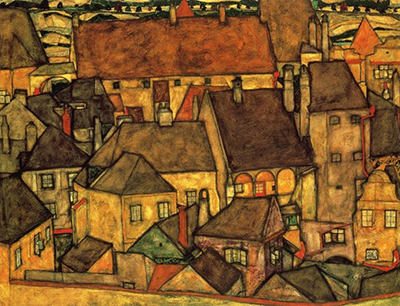The splendour of the Yellow City provides us with one of Schiele's most breaktaking cityscapes, composed in a way that we cannot see neither the start nor the end of this row of buildings.
The Austrian born artist, Egon Schiele, presents a marvellous interpretation of a landscape in all its splendour in his creation of the Yellow City. The composition is defined by strong linearity in Schiele’s own unique and distinctive style, which is immediately visible to the eye. However, with a splash of hues, in particular reds, browns, oranges and yellows, covering the surfaces of the houses, there is an element of warmth to the obvious geometry. Schiele was best known for his ability to experiment with what he was presented with therefore, although the Yellow City suggests a landscape of abundance with its density of clustered houses, upon closer inspection the town is absent of the presence of any human beings. Schiele was the protégé of Gustav Klimt, and it was Klimt who recognised Schiele's desire to create his art to reflect emotion.
This emotion is present in the Yellow City as there is a feeling of a city bonded, in the representation of the houses formations, regardless of them being void of any visible human contact. Though the eye may be drawn towards the build-up of city living, the landscape towards the top of the picture presents a wonderful contrast between the city and the countryside. Behind the condensed city, upon closer inspection, a river flows alongside a row of beautifully coloured trees and open land. Whilst Schiele’s lifestyle was shrouded in controversy, there is no evidence of this in this particular piece, and the Yellow City is visually a world away from some of his more scandalous drawings. The overall impression of this superb piece is ultimately one of vibrancy and fine artistry, and it is little wonder that many have described this as one of Egon Schiele's best pieces.
Schiele would somtimes crop compositions aggressively and within this painting we cannot make out the boundaries of the city, nor even the street. It is as if the artist has taken a selection of the view in front of him at random, and worried more about expressive lines and colour. He would repeat this approach several times within his career at around this time, though most other landscapes and cityscapes were composed in a far more conventional manner - see the likes of Four Trees, House with Shingles and The Bridge, for example. Such is the historic and well preserved nature of this region of Austria in which the artist produced this piece, many of the buildings that you find within this scene may actually still be there today, albeit with interiors that have changed many times over. Schiele was able to travel for free by train for a number of years and took the opportunity to visit all manner of different towns and cities in order to gain inspiration for his work as well as learning more about other aspects of life, as a curious young man.




